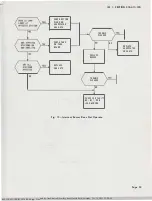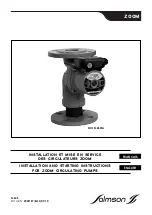
SECTION 5 1 8-4 1 1 -1 00
Access cannot be made when the line is idle or in
the talk mode; therefore, outgoing calls cannot be
made through the 6B KTS.
The CO/PBX line
must be terminated in a 1A1 or 1A2 line circuit
having A lead control. The line circuit is required
to determine whether the CO/PBX line is ringing,
idle, busy, or on hold. Access to the lines in the
proper state is made by dialing a 2-digit code.
Once an incoming call has been answered and put
on hold, the call can be transferred to another
station or a station can be added on.
5. 1 1
Incoming CO/PBX calls are handled by
intercom stations as follows:
(1) When line is called, associated line circuit
will provide flash indication.
(2) Answering station accesses line by dialing a
2-digit CO/PBX access code (80 through 87)
assigned to line.
(3) The answering station can then either:
(a) Handle the call and disconnect by going
on-hook.
(b) Pass the call to another intercom station
by flashing the switchhook to place call
on hold, dialing the other station and, when
they have answered, disconnecting.
(c) Add another station by flashing the
switchhook to place call on hold, dialing
the other station and, when they have answered,
flashing the switchhook a second time to
reenter the original connection.
The above procedure is for 6B KTS stations and
does not prevent the CO/PBX line being picked
up in a normal manner on key system sets if it
appears.
ATTENDANT RECALL
5 . 1 2
T o recall the attendant o n a PBX call that
is connected through the 6B KTS, the
answering station must flash the switchhook which
will return intercom dial tone. The station then
dials
00
which will send a timed flash to the PBX
attendant.
Page
24
6. MAINTENANCE
6.01
Maintenance information pertaining specifically
to the 6B KTS is provided in three forms:
•
Feature sequence charts (Tables F through
0)
•
Trouble analysis charts (Fig. 9 through 18)
•
Diagnostic Test Sequences (Fig. 19 through
30)
Feature Sequence Charts
6.02
These charts provide a method of testing
for the proper sequence of each feature.
No equipment failure indications are given.
Trouble Analysis Charts
6.03
This series of charts provide an analysis of
the probable trouble causes depending on
the more likely trouble reports. Some results may
require further testing using the Diagnostic Test
Sequences.
Diagnostic Tes t Sequences
6.04
These tests require the use of the optional
HK-14 circuit pack (Fig. 8) and a 1013-type
hand test set. Maintenance operations involving
the HK-14 circuit pack should be performed by
2nd-tier maintenance personnel only.
Using the
test sequences, the status of the major signaling
busses and the system power for all links can be
tested. Visual signals are provided on the circuit
pack and audible tones heard in the hand test set.
6.05
The HK-14 circuit pack must be plugged
into J6 in place of the first 484A KTU.
As soon as it is plugged in, the stations associated
with the first 484A KTU will get a system busy
indication, that is, the intercom lamp will light
steadily at the stations. When the ON switch is
operated, all stations will see a system busy and
the system will be taken out of service until the
switch is turned
off.
6.06
To start the sequence after the switch is
turned to ON, 05 must be dialed. The circuit
pack will then test each link for each test. For
instance, after 05 is dialed the digit 1 will be
displayed and link 1 tested for dial tone, then link
BSP 518-411-100-i01_1978-08-24.jpg Scanned by Frank Harrell, (Cowboy Frank) Castle Rock, Colorado Oct 15, 2012 21 :02:40
















































